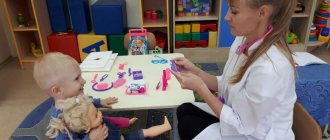Story game "Tea Party"
Summary of the role-playing game "Tea Party".
Target:
developing children’s ability to implement game plans; consolidate children's knowledge about tea utensils.
Tasks
: promote the emergence of a game on a theme from the environment; develop in children the ability to choose a role, perform several interrelated actions in a game, and use substitute objects; bring children to the concept of “family traditions”; fix the name of the elements of tea utensils; develop the ability to set a table and table manners; develop dialogical speech; cultivate friendly, respectful relationships and a friendly attitude towards guests.
Equipment
: a set of teaware, dolls, napkins, a sugar bowl, dummies of cookies, bagels, pieces of cake (salt dough), a teapot.
Preliminary work
: conversation “What is tea utensils for”, looking at tea sets in illustrations, at home; didactic game “Let’s set the table for tea”, “Pick a couple”, “What’s for what”, reading and discussion of K. Chukovsky’s fairy tale “Fly - Tsokotukha”, making dummies of cookies, bagels, cakes (salt dough) with parents.
Progress of the game
Educator. Guys, look, our dolls are sitting on their sofa and, for some reason, are sad. It's snowing outside now, it's very cold. Can you offer them something to make them a little happy? (The teacher leads the children to the fact that in the cold season it is very pleasant and healthy to drink tea (with raspberries, with lemon...). Let's have a real tea party for them! Where do we start? (Children discuss the plot of the game, assign roles , choose a place to play), the teacher prompts as necessary.
Educator. Children, we have so many dishes, maybe we don’t need all of them? (Children name what utensils they will need and why exactly).
Educator. What else do we need besides tea utensils for a pleasant and tasty tea party? (Children’s reasoning).
Educator That's right, and for this, it was not in vain that your mothers tried and made dummies of cakes, cookies and bagels.
Children play out the invented plot, the teacher helps, if necessary, directs the course of the game in the role of a guest along with the dolls.
Educator. Oh, guys, look, the dolls really liked your hospitality and kind attitude. It even seemed to me that they were ready to say thank you. You are very smart, you didn’t fight, you gave in and helped each other like real friends. Everything was so homely. Did you like this wonderful game? (Children's answers).
Educator. So we will definitely play again and invite guests.
Card index of role-playing games in the middle group.
"Polyclinic"Target:
Clarify and expand children’s understanding of the rules of behavior in public places and at clinic appointments; provide insight into the functioning of the human body
Materials, attributes, equipment:
White coats and caps for doctors, numbers for the cloakroom attendant, tables and a pointer for the ophthalmologist, an “X-ray” depicting the internal organs of a person, a phonendoscope, a thermometer and a device for measuring blood pressure for the therapist, a syringe
Progress of the game:
Educator: Today a clinic starts operating in our kindergarten. First of all, upon entering the clinic, you need to undress.
(Children imitate undressing, greet the cloakroom attendant, get a number, thank you)
Educator: Now let's go to the registration desk to get the cards. To receive it, you must provide your last name, first name and address.
(The children take the cards and go to the doctor. The teacher reminds them that they shouldn’t run or scream in the clinic, because people come there who don’t feel very well, and you shouldn’t cause them unnecessary trouble)
Educator: We came to the clinic today to undergo a medical examination, that is, to check whether our body is healthy. First we'll go to the eye doctor's office.
Oculist
(The children enter the office. The doctor takes turns checking the children’s vision using a table. All eyesight is good. He talks about the prevention of eye diseases - you can’t rub your eyes with dirty hands, if a speck gets into the eye, you need to gently stroke the eye towards the nose; tells why glasses are needed: medical glasses improve vision, sunglasses protect the eyes from the bright sun, diving glasses allow you to dive and view the underwater world)
X-ray room
The doctor asks the patient to undress to the waist and stand behind the screen. He takes a photograph, shows it and tells what it shows:
This tube is the esophagus, through which food enters the stomach.
This is the stomach, in which food is digested - useful and necessary substances are absorbed by the body, and unnecessary ones go further and are removed from the body.
These are the lungs - they receive the air we breathe.
This is the heart, it is constantly in motion - like a small pump, pumping blood throughout the body.
The doctor says that in order for all organs to be healthy, it is important to eat healthy food: vegetables and fruits, breathe clean air and exercise.
Otolaryngologist
The doctor examines the ears, throat and nose of the patients, talks about the prevention of ENT diseases: in order to keep the throat healthy, you should not eat ice cream in large pieces, it is harmful to breathe through the mouth - that is what the nose is for. You should not put small objects into your ears and nose - they can get stuck there and will only be removed in the hospital. You cannot listen to loud music or shout loudly, you need to use a handkerchief correctly.
Dermatologist
The doctor examines the patients: asks them to show their hands, stomach, and examines the scalp.
The doctor tells you how to take care of your skin: wash with hot water and soap and a washcloth at least once a day, wash your hands before eating and after visiting the toilet. You should not touch stray animals - you can become infected with a very unpleasant disease. You can only comb your hair with your own comb; you cannot try on other people’s hats - this is necessary so as not to become infected with insects - lice that live on a person’s head.
Therapist
Today we went to the therapist so he could examine us and tell us if everything was okay.
(The doctor measures the temperature, listens to the chest with a phonendoscope, and measures the pressure).
Doctor: Temperature and blood pressure are normal. The heart beats evenly, the lungs breathe well, there is no wheezing in them. You are healthy. But you need to get vaccinated to avoid getting sick. Go to the nurse.
(The nurse wipes her hand with a cotton swab and gives an injection)
Educator: Our visits to the doctors are over. We are healthy and we know how to behave in order to maintain our health.
Long-term plan for the ROLE-PLAYING GAME “Bakery” in the preparatory group.
Conversation about the progress of the game:Question options:
What is the name of the bakery?
What events will take place there?
Sketching a game plan: what's first, what's next, what's next.
Choosing a contract method for discussing the game plan: lots, counting, etc. Creating a storyline (what game situations can be used: a competition for the name “bakery”, about opening a bakery (BEFORE THE GAME),
CONVERSATIONS with children from personal experience about bakeries, conversations about what they read, saw; “Rules for using baking stoves”;
viewing photos, video presentations, video film fragments, etc.
SKETCHING of events in the game.
CONVERSATION with children: who will be who in your game.
You are like (Manager-client (customer),
Dough mixer - baker,
Butcher-baker) what will you do, how will you talk to clients, what will you talk about (for each role). The teacher pays attention to the means of expression: timbre, pitch of voice, gestures, facial expressions, behavior.
What do you need for the game, if this is not there, then what will you replace it with, where will you play in such a way that it is convenient for you and does not disturb others. How can you divide the group space (working with space markers - sketching or working with cards)
Joint play between the teacher and the children * (B - main role, secondary, then vice versa, then “fan of roles”)
Involving the teacher in a joint game in a new role or introducing a new situation. (“An online order has arrived”; “A large cake to order”; “Foreign guests”).
CONVERSATION with children based on photos and story pictures about events in the bakery
CONVERSATION about the rules (at the beginning, during the game, at the end of the game)
RULES for children: ROLE + GAME ACTIONS AND ROLE DIALOGUES.
SKETCHING the rules using a pictogram or drawing (understandable to children)
GAME EXERCISE: who does what
Who interacts with whom, how. Ex. “What comes first, what comes next for every profession”
Organization of design, creation of furniture for cafes,
Organization of manual labor for the production of necessary attributes (menu, holiday program, etc.)
Carrying out a variety of outdoor games, a selection of attractions that may be used in the game (drawn)
Selection of necessary AUDIO means: musical
CONVERSATION with children after the game.
-you liked the way you played
-Why
(it was interesting, they played together, I was able to play this role well...)
- you managed to play together (everyone played their roles)
- who was who in your game
- and you are like a baker, dough mixer, manager
(the child must explain, in accordance with the role, what “I WAS GOOD” means)
- and it was convenient for you to play,
you didn't interfere with each other
-Did everything work out for you?
-what can you change (invent) next time to make it even more interesting?


